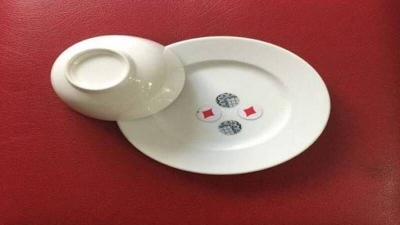6686 bet - Nhà cái uy tín tham gia 6686bet nhận 188k
6686 VN Net là trang cá cược uy tín số 1 Việt Nam, 6686 bet với có tỷ lệ trả thưởng cao - nhiều chương trình khuyến mãi đặc biệt.
Nhà cái trực tuyến 6686 là điểm đến lý tưởng cho những người yêu thích sự hồi hộp và thách thức của cá cược trực tuyến. Với một danh mục đa dạng của các trò chơi từ cá cược thể thao đến sòng bạc trực tuyến, nhà cái mang đến cho người chơi trải nghiệm độc đáo và phong phú.
Giới thiệu đôi điều về trang 6686vn net

6686 đảm bảo bảo mật thông tin cá nhân và tài khoản của người chơi
6686 bet là địa chỉ hàng đầu trong lĩnh vực cá cược trực tuyến, 6686 vn bet có nhiều sảnh chơi như: AG, AE, Evol, tải app 6686bet nhà cái tặng tiền nhận 188k free.
| Nhà cái | 6686vn Net |
| Logo |  |
| Giấy phép | Philippines cấp phép 6686vn Net chuẩn PAGCOR |
| Điện thoại | 08324663211 |
| 6686vnnet@gmail.com | |
| Trụ sở chính | Manila, Philippines |
| Văn phòng VN | 62 Đường Đô Đốc Long, Tân Quý, Tân Phú, Thành phố Hồ Chí Minh |
| Đang online | 180,963 thành viên đang chơi |
| Thành viên | 8,765,860 tài khoản đã đăng ký |
Một điểm đặc biệt của nhà cái chính là sự đa dạng và phong phú của các trò chơi mà họ cung cấp. Từ cá cược thể thao truyền thống đến các trò chơi sòng bạc trực tuyến đầy hấp dẫn như baccarat, blackjack, roulette và nhiều trò chơi slot phong phú khác. Sự đa dạng này giúp người chơi có nhiều lựa chọn để thỏa mãn sở thích cá nhân và tìm ra trò chơi phù hợp nhất.
Ngoài ra, nhà cái uy tín cũng nổi bật với dịch vụ khách hàng chuyên nghiệp và nhiệt tình. Đội ngũ hỗ trợ khách hàng của họ luôn sẵn sàng hỗ trợ người chơi mọi lúc, mọi nơi thông qua nhiều kênh liên lạc khác nhau như email, điện thoại, hoặc trò chuyện trực tuyến.
Không chỉ dừng lại ở đó, chúng tôi còn nổi bật với các chương trình khuyến mãi và ưu đãi hấp dẫn. Từ tiền thưởng đăng ký, thưởng nạp tiền, đến các chương trình khuyến mãi hàng ngày, hàng tuần và hàng tháng, người chơi jun88 đăng nhập luôn có cơ hội nhận được những phần thưởng giá trị.
Đặc biệt, nhà cái luôn coi trọng việc bảo vệ thông tin cá nhân và tài khoản của người chơi. Họ sử dụng các biện pháp bảo mật tiên tiến để đảm bảo rằng mọi giao dịch và thông tin cá nhân đều được bảo vệ một cách an toàn và riêng tư.
Ngoài ra, nhà cái này còn liên kết với trang xôi lạc tổ chức nhiều sự kiện thể thao cùng nhiều loại kèo cược hấp dẫn nhằm phục vụ nhu cầu của người hâm mộ xem trực tiếp bóng đá hôm nay cũng như người chơi cá cược trên toàn thế giới.
Các trò chơi đổi thưởng cực hấp dẫn tại nhà cái 6686 bet

Nhà cái có một cộng đồng người chơi rộng lớn và tích cực
Tại nhà cái 6686 bet, trải nghiệm game bài đỉnh cao không chỉ là một hành trình giải trí mà còn là cuộc phiêu lưu đầy thú vị vào thế giới của các tựa game đa dạng và hấp dẫn. Dưới đây là một số tựa game nổi bật mà bạn không nên bỏ lỡ khi tham gia sân chơi cá cược tại nhà cái uy tín này.
Game Slot
Trong danh sách các trò chơi đổi thưởng tại nhà cái 6686bet, game slot là một trong những trải nghiệm không thể bỏ qua. Với sự đa dạng về chủ đề từ những câu chuyện cổ tích đến những thế giới huyền bí, game slot tại 6686vn.net đem đến cho người chơi colatv những giây phút giải trí đầy thú vị và cơ hội trúng thưởng lớn. Không chỉ là những tựa game slot phổ biến, mà còn có những phiên bản mới, sáng tạo với đồ họa và hiệu ứng âm thanh đỉnh cao, khiến cho việc quay và thắng trở nên thú vị hơn bao giờ hết.
Nổ Hũ
Nổ hũ là một trong những trò chơi được ưa chuộng tại 6686 bet, với lối chơi đơn giản nhưng mang lại cảm giác hồi hộp và phấn khích. Người chơi sẽ được tham gia vào cuộc chiến với may mắn, chờ đợi những phần thưởng hấp dẫn từ những lượt quay của máy nổ hũ. Với các tính năng đặc biệt và tỉ lệ trúng thưởng cao, trò chơi này luôn là điểm sáng trong danh sách trò chơi tại trực tiếp bóng đá hôm nay 6686 bet.
Bắn Cá
Bắn cá là một trò chơi thú vị và đầy lôi cuốn tại 6686bet. Với đồ họa sắc nét, hiệu ứng đẹp mắt và cơ chế chơi đơn giản, người chơi colatv sẽ được trải nghiệm cuộc săn cá đầy kịch tính và phấn khích. Hãy tham gia vào thế giới dưới đại dương sâu thẳm, bắn cá và thu thập những phần thưởng lớn từ những con cá khổng lồ.
Các Loại Game Casino
-
Baccarat: Trò chơi đơn giản nhưng không kém phần hấp dẫn, với cơ hội chiến thắng cao và tính giải trí tuyệt vời.
-
Tài Xỉu: Trò chơi dựa trên dự đoán kết quả của ba con xúc xắc, mang lại sự hồi hộp và thú vị cho người chơi.
-
Xóc Đĩa: Dựa trên việc dự đoán kết quả của viên xúc xắc, với tính giải trí cao và cơ hội chiến thắng lớn.
-
Roulette: Trò chơi quay số với nhiều cách cược và cơ hội thắng lớn, làm say đắm lòng người với sự hấp dẫn và đa dạng.
-
Rồng Hổ: So sánh giữa hai lá bài, với cơ hội trúng thưởng cao và tính chất hấp dẫn.
Game Bài
-
Xì Dách: Trò chơi đòi hỏi sự chiến thuật và suy luận để đạt điểm số cao nhất.
-
Poker: Trò chơi kinh điển với nhiều biến thể khác nhau, đem lại cảm giác hồi hộp và thú vị cho người chơi.
-
Sâm Lốc: Phổ biến với cách chơi đơn giản và tính giải trí cao.
-
Mậu Binh: Yêu cầu sự tư duy và chiến thuật để giành chiến thắng.
-
Bài Cào: Đơn giản nhưng không kém phần thú vị, đem lại những trải nghiệm độc đáo cho người chơi game bài đổi thưởng.
-
Tá Lả: Dễ chơi và giải trí cao.
-
Trác Kim Hoa: Dựa trên sự may mắn và kỹ năng của người chơi.
Cược Thể Thao
Bên cạnh các trò chơi trên, 6686bet còn liên kết với trang ca khia tv cung cấp các hình thức cược thể thao trực tuyến, cho phép người chơi cũng như người hâm mộ xem trực tiếp bóng đá hôm nay, đặt cược vào các trận đấu và sự kiện thể thao hàng đầu trên thế giới. Các trận đấu bóng đá tại nhà cái 6686 đều được kênh bóng đá xoilac trực tiếp hoàn toàn miễn phí cùng với bình luận chuyên nghiệp đưa ra các kèo cược hấp dẫn cho anh em.
Đua Ngựa - Đua Chó
Trải nghiệm đua ngựa và đua chó tại 6686bet, cảm nhận sự hồi hộp và kịch tính của những trận đua đầy cam go, hứa hẹn mang lại những phút giây giải trí không thể quên.
Đá Gà
Cuối cùng, trò chơi đá gà là một trong những lựa chọn thú vị tại bóng đá trực tiếp hôm nay 6686vn net, với các trận đấu đầy kịch tính và cơ hội trúng thưởng lớn. Đắm chìm trong không khí sôi động và hấp dẫn của các trận chiến, người chơi sẽ được tham gia vào những cuộc đối đầu nảy lửa giữa những con gà võ nghệ, tạo nên những trải nghiệm không thể nào quên trong lòng người chơi.
Cuối cùng, với sự đa dạng và phong phú của các trò chơi đổi thưởng tại nhà cái 6686vn net, người chơi không chỉ được trải nghiệm những giờ phút giải trí thú vị mà còn có cơ hội trúng thưởng lớn. Với game slot, nổ hũ, bắn cá, các trò casino, game bài, cược thể thao, keo nha cai đua ngựa - đua chó và đá gà, bongdaso 6686vn.net mang đến một không gian giải trí đa dạng và hấp dẫn, hứa hẹn mang lại những trải nghiệm đặc biệt và không thể quên cho người chơi.
Chia sẻ các bước tải app 6686vn net

Nhà cái uy tín 6686bet cung cấp một loạt các trò chơi cá cược
Để mọi người trải nghiệm và tránh nhầm lẫn với các đường link không an toàn, việc tải ứng dụng nhà cái trở nên cực kỳ quan trọng. Dưới đây là một hướng dẫn chi tiết về cách thức thực hiện quy trình này, nhằm đảm bảo sự dễ dàng và an toàn cho người chơi 789 bet:
-
Bước 1: Tìm đường dẫn đúng: Trước hết, bạn cần truy cập vào trang chính của nhà cái nhà cái thông qua đường dẫn. Điều này sẽ giúp bạn tránh xa các đường link trực tiếp bóng đá giả mạo hoặc không an toàn. Luôn lưu ý chú ý kỹ các link trong header của Google hoặc sử dụng cú pháp “App 6686vn net” khi tìm kiếm trên công cụ tìm kiếm để chắc chắn rằng bạn đang truy cập vào trang chính xác.
-
Bước 2: Tải ứng dụng: Nếu bạn muốn tải ứng dụng về điện thoại của mình, hãy quét một trong hai mã QR được cung cấp bởi nhà cái. Điều này sẽ bắt đầu quá trình tải ứng dụng một cách nhanh chóng và thuận tiện. Để thực hiện việc này, chỉ cần truy cập trang web xem trực tiếp bóng đá và chọn liên kết tải xuống.
-
Bước 3: Lựa chọn hệ điều hành: Sau khi bạn đã chọn một trong ba tùy chọn tải xuống được cung cấp, nhấp vào biểu tượng điện thoại nằm ở góc trên bên phải của màn hình, gần thanh công cụ. Điều này sẽ đưa bạn đến một trang với hai mã QR, mỗi mã phù hợp với một hệ điều hành cụ thể.
-
Bước 4: Tải xuống từ App Store hoặc Play Store: Để tải ứng dụng về điện thoại, bạn sẽ được chuyển đến cửa hàng ứng dụng tương ứng với hệ điều hành của mình, có thể là App Store (đối với iOS) hoặc Play Store (đối với Android). Tại đây, bạn chỉ cần chọn tùy chọn cài đặt và đợi cho quá trình tải xuống và cài đặt hoàn tất.
Cách đăng nhập và đăng ký tại nhà cái uy tín 6686 bet

Sự uy tín và độ tin cậy của nha cai uy tin đã được khẳng định qua sự ủng hộ của người chơi
Khi nói đến việc đăng nhập và đăng ký tại một nhà cái uy tín như 6686 bet, Với sự kết hớp giữa nhà cái 6686 và trang truc tiep bong da, đã đưa ra quy trình đăng nhập và đăng ký một cách đơn giản và tiện lợi. Để trải nghiệm các dịch vụ xem bong da truc tiep và trò chơi cá cược tại nhà cái, việc đăng ký và đăng nhập là bước đầu tiên và quan trọng. Hãy cùng tìm hiểu quy trình này để bắt đầu hành trình cá cược trực tuyến của bạn.
Đăng nhập
Để đăng nhập vào nhà cái, bạn có thể tuân theo các bước sau:
-
Bước 1: Truy cập vào trang chủ của nhà cái bằng cách nhập địa chỉ trang web xem bóng đá trực tuyến chính thức vào trình duyệt của bạn.
-
Bước 2: Tại trang chủ, tìm và nhấn vào nút "Đăng nhập" hoặc "Login". Thường thì nút này sẽ được đặt ở góc trên bên phải của trang web.
-
Bước 3: Một cửa sổ đăng nhập sẽ xuất hiện, yêu cầu bạn nhập thông tin tài khoản của mình. Hãy nhập Tên đăng nhập (Username) và Mật khẩu (Password) vào các ô tương ứng.
-
Bước 4: Sau khi nhập đầy đủ thông tin, nhấn vào nút "Đăng nhập" để tiến hành đăng nhập vào tài khoản của bạn.
-
Bước 5: Nếu bạn nhập đúng thông tin đăng nhập, hệ thống sẽ chuyển bạn đến giao diện chính của nhà cái truc tiep bong da, nơi bạn có thể trải nghiệm các trò chơi và dịch vụ khác của họ.
Đăng ký
Để đăng ký tài khoản tại chúng tôi, anh em có thể thực hiện theo các bước dưới đây:
-
Bước 1: Truy cập vào trang chủ của xem bong da truc tuyen, được quản lý bởi frdi.net. Sau khi truy cập, anh em chọn vào phần "Đăng ký tài khoản" để bắt đầu quá trình đăng ký.
-
Bước 2: Nhập thông tin cá nhân của mình vào các ô tương ứng, bao gồm tên đăng nhập, mật khẩu, email xác nhận và số điện thoại. Lưu ý là cần phải nhập thông tin chính xác và đúng với thông tin thực sự của anh em.
-
Bước 3: Sau khi hoàn thành việc nhập thông tin, anh em nhấp chuột vào nút "Đăng ký" tại trang cá độ bóng đá. Nếu thông tin được nhập vào chính xác và không có trùng lặp, hệ thống sẽ thông báo thành công. Tuy nhiên, nếu có bất kỳ sai sót nào, anh em cần kiểm tra lại thông tin của mình trước khi tiếp tục.
Hướng dẫn cách nạp tiền 6686vn net

Nhà cái 6686bet thường xuyên cập nhật và cung cấp thông tin mới nhất về các sự kiện thể thao và cơ hội cá cược
Để nạp tiền vào tài khoản trên 6686 bet, bạn có thể thực hiện theo các bước sau đây:
-
Bước 1: Đăng nhập vào tài khoản của bạn: Truy cập vào trang chủ của trực tiếp bóng đá và đăng nhập vào tài khoản cá nhân của bạn bằng cách nhập tên đăng nhập và mật khẩu vào các ô tương ứng. Nếu bạn chưa có tài khoản, hãy đăng ký một tài khoản mới.
-
Bước 2: Truy cập vào trang nạp tiền: Sau khi đăng nhập thành công, tìm và chọn mục "Nạp tiền" hoặc "Nạp Fund" trên giao diện của trang web. Thường thì mục này được đặt ở phần menu chính hoặc góc trên bên phải của trang web.
-
Bước 3: Chọn phương thức thanh toán: Tại trang nạp tiền, bạn sẽ thấy danh sách các phương thức thanh toán khác nhau như chuyển khoản ngân hàng, ví điện tử, thẻ cào điện thoại, hoặc các hình thức thanh toán trực tuyến khác. Chọn phương thức thanh toán phù hợp với bạn.
-
Bước 4: Nhập thông tin và số tiền cần nạp: Sau khi chọn phương thức thanh toán, bạn sẽ được yêu cầu nhập thông tin cần thiết như số tiền muốn nạp và các thông tin liên quan đến phương thức thanh toán bạn đã chọn. Hãy nhập thông tin một cách chính xác và kiểm tra kỹ trước khi xác nhận giao dịch.
-
Bước 5: Xác nhận giao dịch: Sau khi đã nhập đầy đủ thông tin, hãy kiểm tra lại một lần nữa để đảm bảo tính chính xác của giao dịch. Tiếp theo, nhấn vào nút "Xác nhận" hoặc "Nạp tiền" để hoàn tất giao dịch nạp tiền.
-
Bước 6: Kiểm tra số dư tài khoản trang cá độ bóng đá uy tín: Sau khi hoàn tất giao dịch, bạn có thể kiểm tra lại số dư trong tài khoản để đảm bảo rằng số tiền đã được nạp thành công. Thường thì số dư sẽ được cập nhật ngay lập tức sau khi giao dịch thành công.
Cách rút tiền tại nhà cái 6686bet cực chuẩn

Nhà cái uy tín 6686 bet tuân thủ các nguyên tắc của trò chơi công bằng
Để thực hiện việc rút tiền từ tài khoản của bạn trên 6686 bet, bạn có thể tuân theo các bước sau đây:
-
Bước 1: Đăng nhập vào tài khoản của bạn: Truy cập vào trang chủ của kèo nhà cái và đăng nhập vào tài khoản cá nhân của bạn bằng cách nhập tên đăng nhập và mật khẩu vào các ô tương ứng.
-
Bước 2: Truy cập vào mục rút tiền trang cá cược bóng đá : Sau khi đăng nhập thành công, tìm và chọn mục "Rút tiền" hoặc "Withdrawal" trên giao diện của trang web. Thường thì mục này được đặt ở phần menu chính hoặc góc trên bên phải của trang web.
-
Bước 3: Chọn phương thức rút tiền: Tại trang rút tiền, bạn sẽ thấy danh sách các phương thức rút tiền khác nhau như chuyển khoản ngân hàng, ví điện tử, hoặc các hình thức thanh toán khác. Chọn phương thức rút tiền phù hợp với bạn.
-
Bước 4: Nhập thông tin và số tiền cần rút: Sau khi chọn phương thức rút tiền, bạn sẽ được yêu cầu nhập thông tin cần thiết từ trang cá cược bóng đá uy tín như số tiền muốn rút và các thông tin liên quan đến phương thức rút tiền bạn đã chọn. Hãy nhập thông tin một cách chính xác và kiểm tra kỹ trước khi xác nhận giao dịch.
-
Bước 5: Xác nhận giao dịch: Kiểm tra lại một lần nữa để đảm bảo tính chính xác của thông tin đã nhập và sau đó nhấn vào nút "Xác nhận" hoặc "Rút tiền" để hoàn tất giao dịch rút tiền.
-
Bước 6: Kiểm tra tài khoản ngân hàng: Sau khi giao dịch được xử lý thành công, số tiền rút từ tài khoản của bạn sẽ được chuyển đến tài khoản ngân hàng của bạn. Hãy kiểm tra tài khoản ngân hàng của mình để đảm bảo rằng số tiền đã được chuyển thành công.
Tham khảo thêm:
Kênh trực tiếp bóng đá:
- Kênh xem trực tiếp bóng đá hôm nay (cultureandyouth.org)
- Kênh xoilac (phongkhamago.com)
- Kênh xoi lac tv (anstad.com)
- Kênh xoilac 7 (sosmap.net)
- Oxbet - Nhà cái cá cược online uy tín mang tầm quốc tế
- Danh sách top 10 thủ môn hay nhất của bóng đá thế giới - Điểm tựa nơi khung gỗ
- Bsport – Sự lựa chọn cá cược uy tín và hấp dẫn cho cược thủ
- Top 5+ ngôi sao trẻ tiềm năng nhất Ngoại Hạng Anh: “Món hời” Palmer
- Tf88 - Nhà cái cá cược với kho game phong phú nhất thị trường
- Top 5 câu lạc bộ vô địch nhiều nhất Seagames
- Cầu thủ Cristiano Ronaldo - Ông hoàng của sự chăm chỉ và cố gắng
- CLB Real Madrid: Ông vua của đấu trường Champions League
- Manchester United - Con đường tìm lại lịch sử lẫy lừng













.jpg)

.jpg)
.jpg)
.jpg)
.jpg)
.jpg)
.jpg)
.jpg)
.jpg)










.jpg)
.jpg)

.jpg)

.jpg)



.jpg)
























